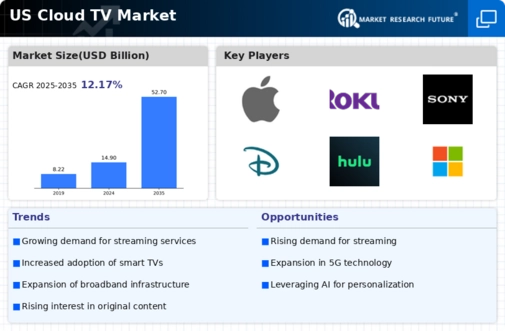Rising Demand for On-Demand Content
The cloud tv market experiences a notable surge in demand for on-demand content, driven by changing consumer preferences. Viewers increasingly favor the flexibility of accessing their favorite shows and movies at their convenience. According to recent data, approximately 70% of households in the US subscribe to at least one streaming service, highlighting the shift from traditional cable to cloud-based platforms. This trend indicates a growing reliance on cloud technology to deliver content seamlessly. As consumers seek personalized viewing experiences, the cloud tv market is likely to expand, with providers investing in advanced algorithms to recommend content tailored to individual tastes. This demand for on-demand content not only enhances user engagement but also encourages competition among service providers, further propelling the growth of the cloud tv market.
Growing Integration of Smart Devices
The integration of smart devices into everyday life significantly influences the cloud tv market. As smart TVs, streaming devices, and mobile applications become increasingly prevalent, consumers are more inclined to access cloud-based content through these technologies. Recent surveys indicate that approximately 75% of US households own at least one smart device capable of streaming content. This widespread adoption facilitates seamless access to cloud tv services, enhancing user convenience and engagement. Moreover, the compatibility of cloud platforms with various devices allows for a more cohesive viewing experience, as users can switch between devices without interruption. As the trend of smart device integration continues, the cloud tv market is likely to benefit from increased user adoption and engagement, further solidifying its position in the entertainment landscape.
Increased Focus on Content Diversity
The cloud tv market is increasingly characterized by a focus on content diversity, as providers strive to cater to a wide range of audience preferences. This trend is evident in the growing number of platforms that offer niche content, including international films, documentaries, and specialized genres. As of November 2025, it is reported that over 60% of consumers express a desire for more diverse programming options. In response, streaming services are investing in original content production and acquiring licensing rights to a broader array of shows and films. This emphasis on content diversity not only attracts new subscribers but also enhances viewer retention, as audiences are more likely to remain loyal to platforms that offer a rich variety of content. Consequently, the cloud tv market is poised for continued expansion as it adapts to the evolving tastes of consumers.
Technological Advancements in Streaming
Technological advancements play a pivotal role in shaping the cloud tv market. Innovations such as 5G connectivity and improved bandwidth capabilities facilitate smoother streaming experiences, reducing buffering times and enhancing video quality. As of November 2025, it is estimated that over 50% of US households have access to high-speed internet, which significantly supports the adoption of cloud-based services. Furthermore, the integration of artificial intelligence and machine learning into streaming platforms allows for more efficient content delivery and user interaction. These advancements not only improve the overall viewing experience but also attract new subscribers, thereby contributing to the growth of the cloud tv market. As technology continues to evolve, it is anticipated that the market will witness further enhancements, making streaming services more accessible and appealing to a broader audience.
Shift from Traditional Cable to Streaming
The cloud tv market is currently witnessing a pronounced shift from traditional cable television to streaming services. This transition is largely attributed to the increasing costs associated with cable subscriptions, which have risen by approximately 30% over the past decade. In contrast, cloud-based services often provide more affordable options, with many platforms offering subscription plans that cater to diverse budgets. As consumers become more cost-conscious, the appeal of cloud tv services grows, leading to a decline in cable subscriptions. Recent statistics indicate that nearly 40% of US households have cut the cord, opting for streaming alternatives instead. This shift not only reflects changing consumer behavior but also underscores the potential for growth within the cloud tv market as more viewers seek economical and flexible viewing solutions.

















Leave a Comment